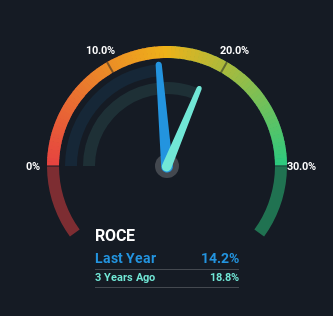
If you're looking for a multi-bagger, there's a few things to keep an eye out for. In a perfect world, we'd like to see a company investing more capital into its business and ideally the returns earned from that capital are also increasing. If you see this, it typically means it's a company with a great business model and plenty of profitable reinvestment opportunities. Speaking of which, we noticed some great changes in Dekpol's (WSE:DEK) returns on capital, so let's have a look.
What Is Return On Capital Employed (ROCE)?
If you haven't worked with ROCE before, it measures the 'return' (pre-tax profit) a company generates from capital employed in its business. The formula for this calculation on Dekpol is:
Return on Capital Employed = Earnings Before Interest and Tax (EBIT) ÷ (Total Assets - Current Liabilities)
0.14 = zł118m ÷ (zł1.5b - zł676m) (Based on the trailing twelve months to September 2023).
Thus, Dekpol has an ROCE of 14%. In absolute terms, that's a pretty normal return, and it's somewhat close to the Construction industry average of 13%.
Check out our latest analysis for Dekpol

While the past is not representative of the future, it can be helpful to know how a company has performed historically, which is why we have this chart above. If you'd like to look at how Dekpol has performed in the past in other metrics, you can view this free graph of past earnings, revenue and cash flow.
So How Is Dekpol's ROCE Trending?
The trends we've noticed at Dekpol are quite reassuring. The data shows that returns on capital have increased substantially over the last five years to 14%. The company is effectively making more money per dollar of capital used, and it's worth noting that the amount of capital has increased too, by 98%. The increasing returns on a growing amount of capital is common amongst multi-baggers and that's why we're impressed.
On a side note, Dekpol's current liabilities are still rather high at 45% of total assets. This can bring about some risks because the company is basically operating with a rather large reliance on its suppliers or other sorts of short-term creditors. Ideally we'd like to see this reduce as that would mean fewer obligations bearing risks.
What We Can Learn From Dekpol's ROCE
To sum it up, Dekpol has proven it can reinvest in the business and generate higher returns on that capital employed, which is terrific. And investors seem to expect more of this going forward, since the stock has rewarded shareholders with a 59% return over the last five years. With that being said, we still think the promising fundamentals mean the company deserves some further due diligence.
Before jumping to any conclusions though, we need to know what value we're getting for the current share price. That's where you can check out our FREE intrinsic value estimation that compares the share price and estimated value.
While Dekpol isn't earning the highest return, check out this free list of companies that are earning high returns on equity with solid balance sheets.
New: Manage All Your Stock Portfolios in One Place
We've created the ultimate portfolio companion for stock investors, and it's free.
• Connect an unlimited number of Portfolios and see your total in one currency
• Be alerted to new Warning Signs or Risks via email or mobile
• Track the Fair Value of your stocks
Have feedback on this article? Concerned about the content? Get in touch with us directly. Alternatively, email editorial-team (at) simplywallst.com.
This article by Simply Wall St is general in nature. We provide commentary based on historical data and analyst forecasts only using an unbiased methodology and our articles are not intended to be financial advice. It does not constitute a recommendation to buy or sell any stock, and does not take account of your objectives, or your financial situation. We aim to bring you long-term focused analysis driven by fundamental data. Note that our analysis may not factor in the latest price-sensitive company announcements or qualitative material. Simply Wall St has no position in any stocks mentioned.
About WSE:DEK
Dekpol
Dekpol S.A. primary engages in the general contracting and property development businesses in Poland.
Excellent balance sheet with acceptable track record.
Market Insights
Community Narratives




